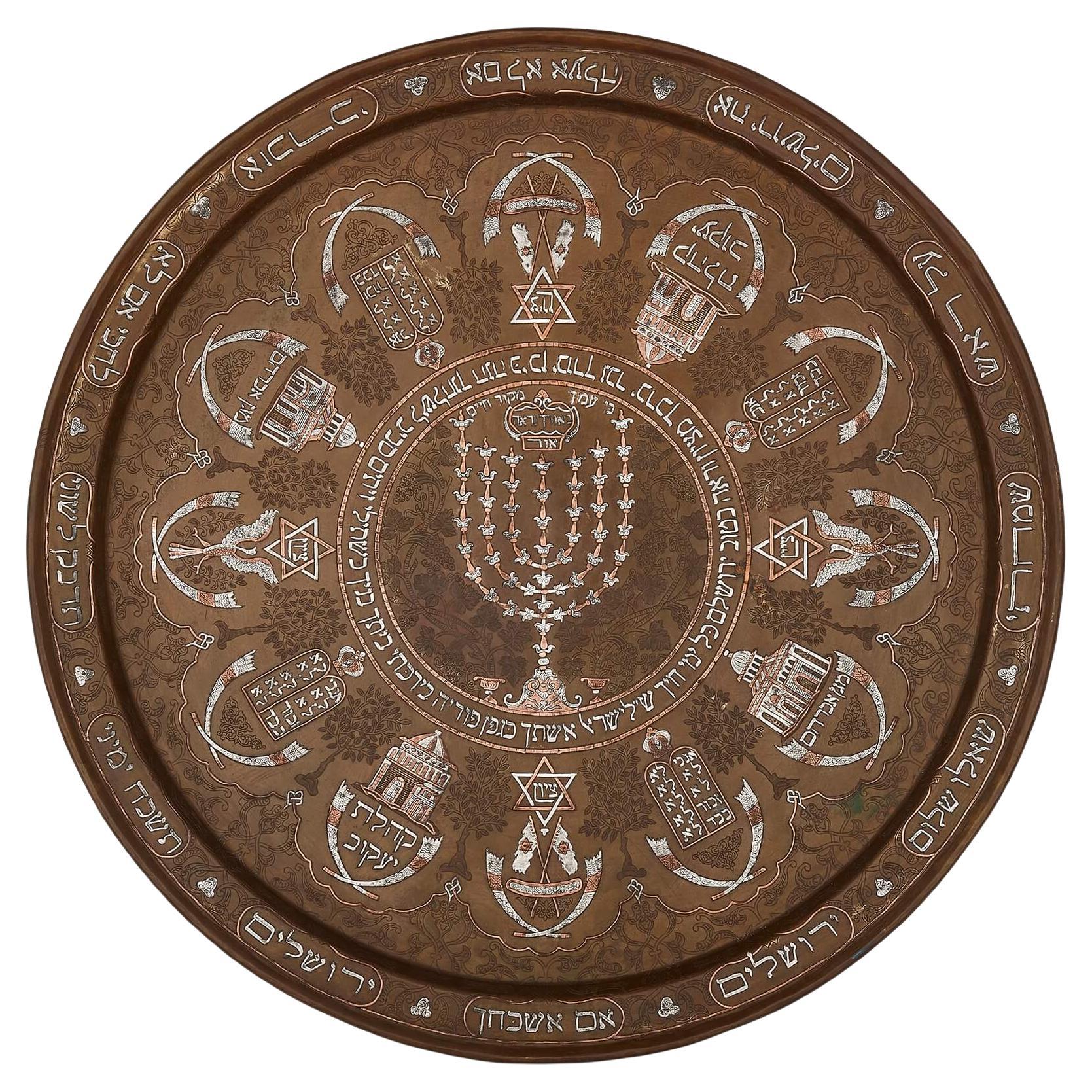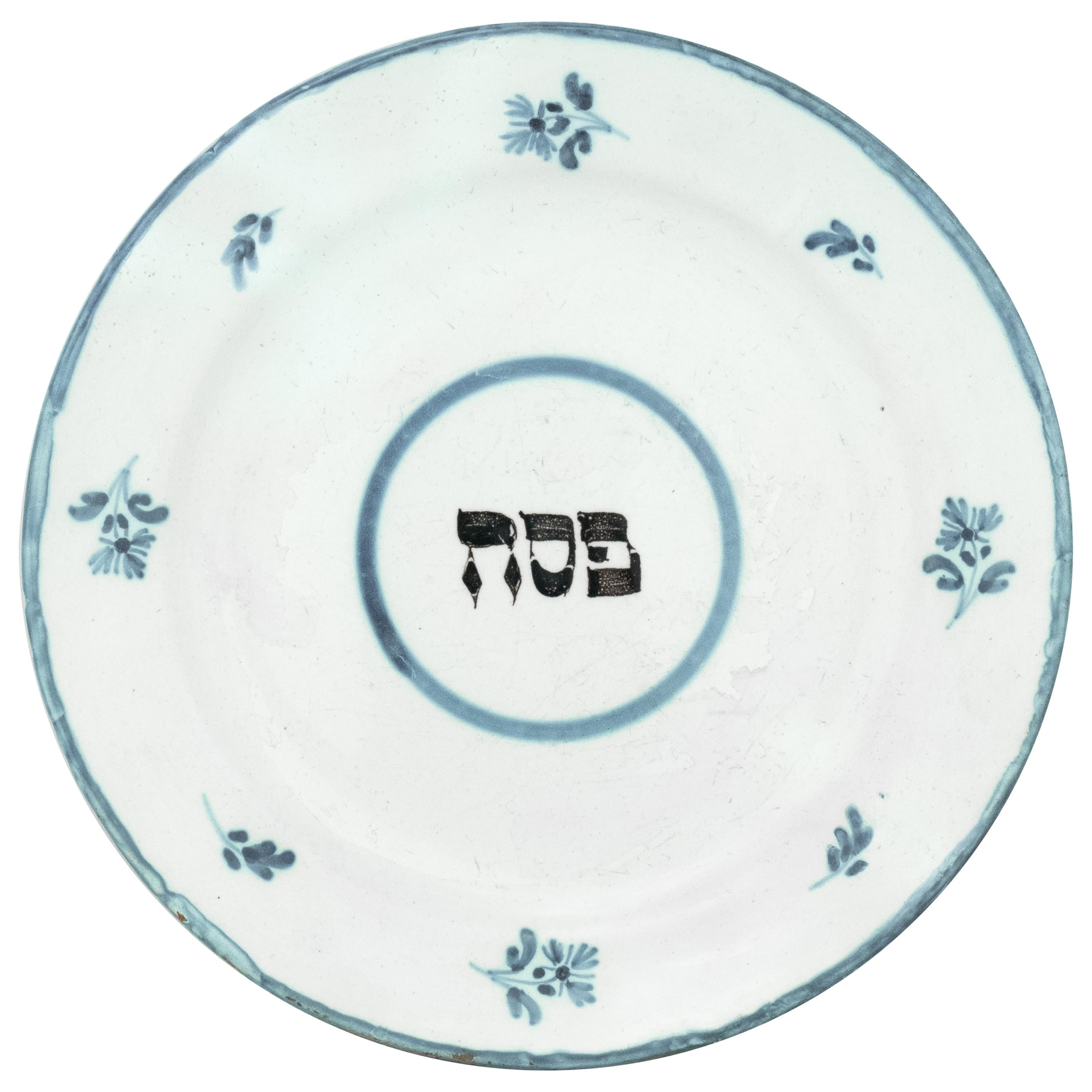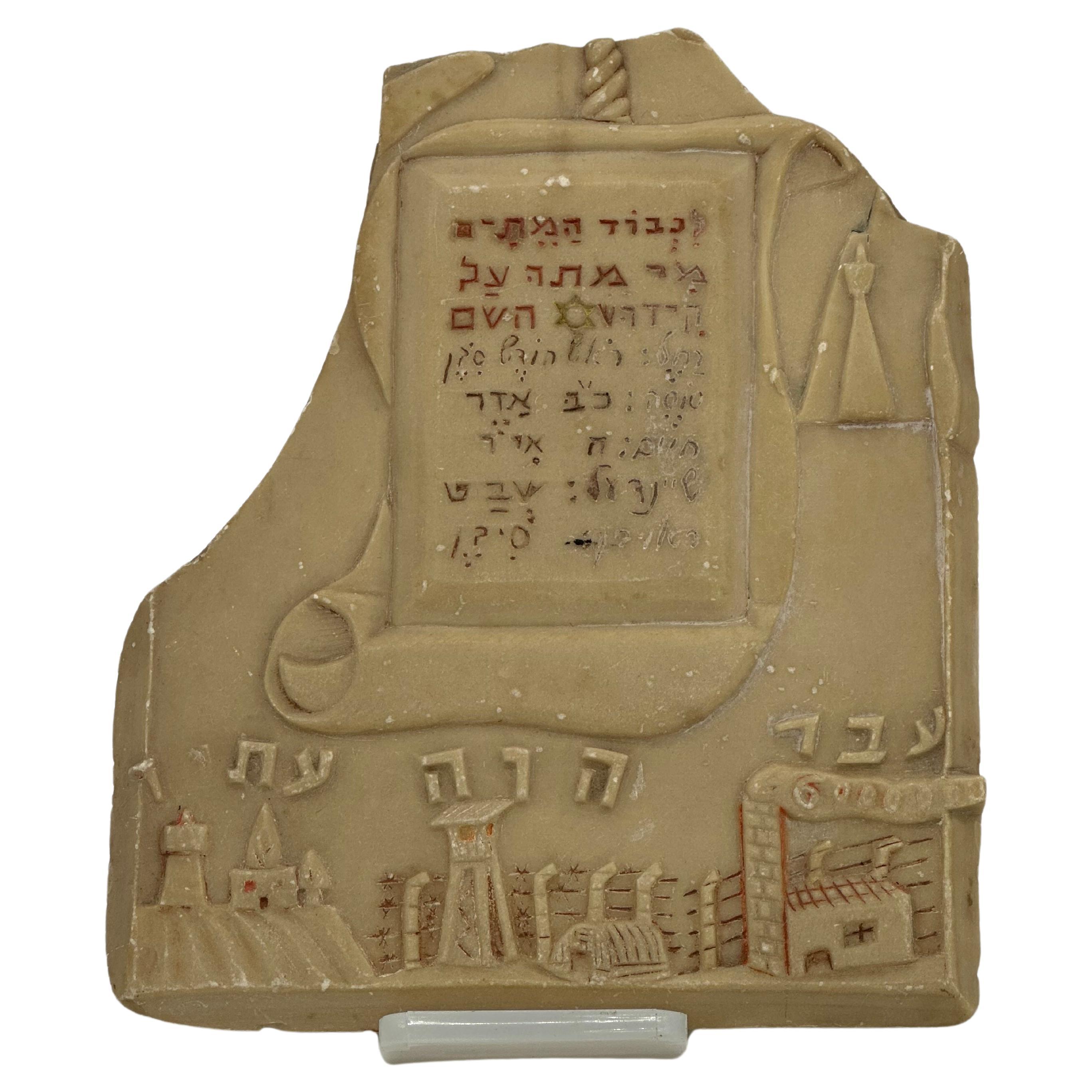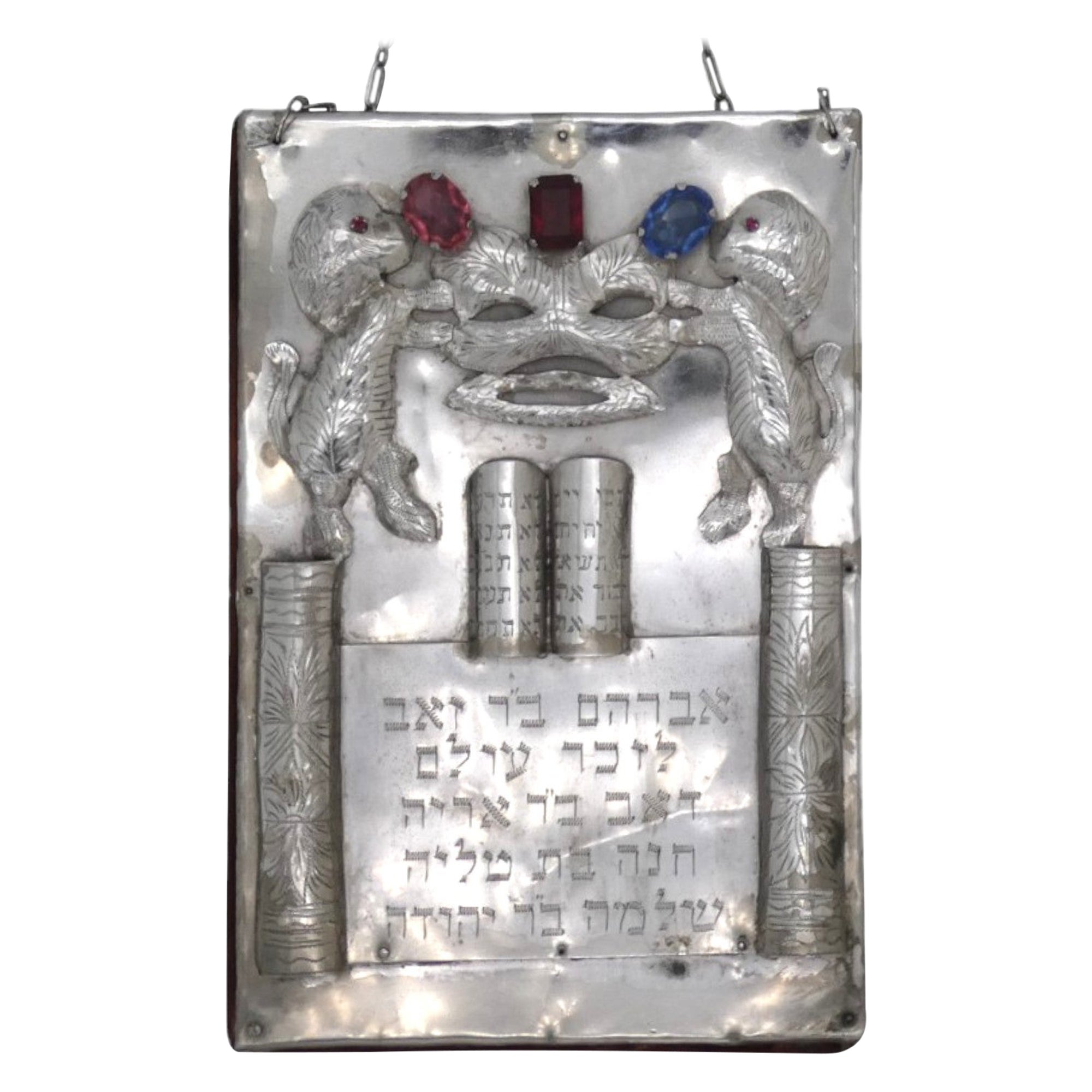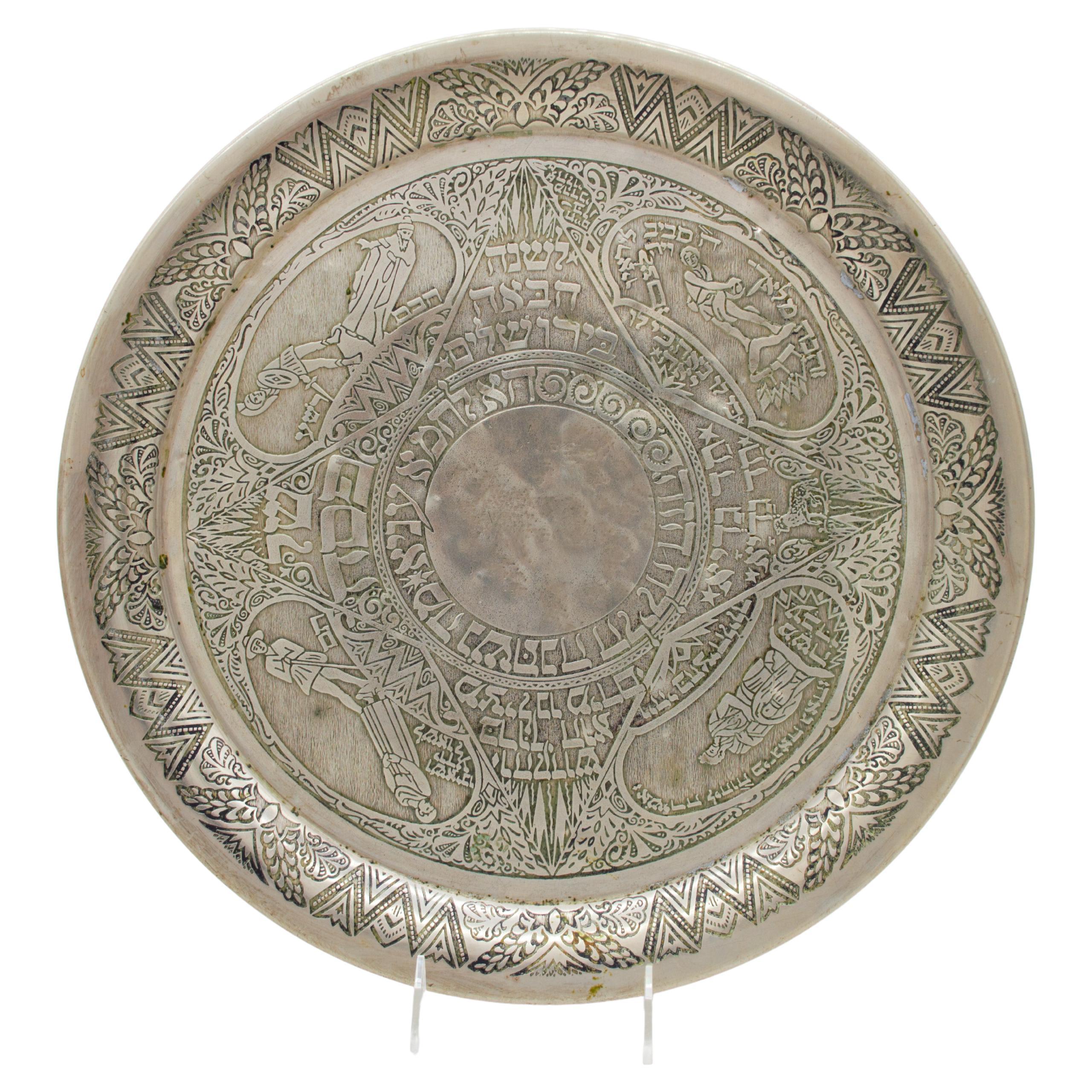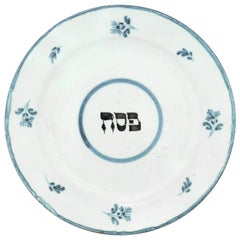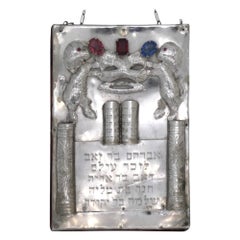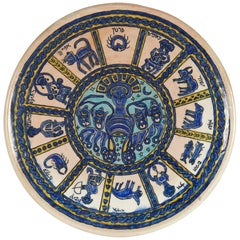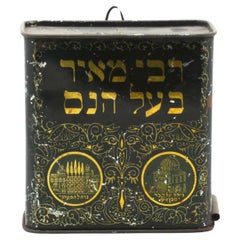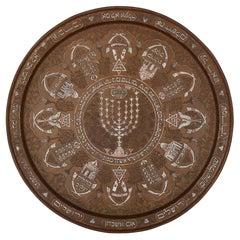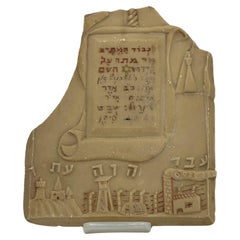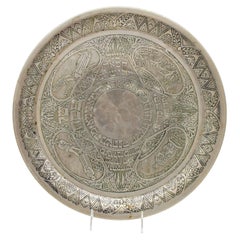Items Similar to Early 20th Century Bezalel Jerusalem Shabbat Tray
Want more images or videos?
Request additional images or videos from the seller
1 of 15
Early 20th Century Bezalel Jerusalem Shabbat Tray
$15,000
$18,75020% Off
£11,338.14
£14,172.6820% Off
€13,029.54
€16,286.9320% Off
CA$20,887.41
CA$26,109.2620% Off
A$23,236.39
A$29,045.4820% Off
CHF 12,180.80
CHF 15,226.0120% Off
MX$283,942.95
MX$354,928.6920% Off
NOK 155,107.35
NOK 193,884.1820% Off
SEK 146,012.11
SEK 182,515.1320% Off
DKK 97,260.57
DKK 121,575.7120% Off
Shipping
Retrieving quote...The 1stDibs Promise:
Authenticity Guarantee,
Money-Back Guarantee,
24-Hour Cancellation
About the Item
Early 20th century Bezalel Jerusalem wooden tray inlaid with Jerusalem stone and mother of pearl.
The large tray is carved with the Seven Species on its margins, while the center is inlaid with Jerusalem stone plaques shaped as the Tablets of the Law with inscribed blessings - "HaMotzih" and "Boreh Pri HaGafen". Around this image are inlaid pieces of mother of pearl. An inlaid piece of mother of pearl shaped as a Star of David appears below the Tablets, with an engraved inscription: "If I Forget Thee, O Jerusalem, Let my Right Hand Forget its Skill" (Hebrew).
Inlaid all around in a circle, are Jerusalem stone plaques with the symbols of the Tribes and around them blue wooden plaques with the words "Eat your bread with joy…" (Hebrew) and mother of pearls plaques decorated with views of the Temple Mount, Rachel's Tomb, Tower of David, Cave of the Patriarchs and Bezalel buildings.
The catalogue "Early Israeli Arts and Crafts, Bezalel Treasures from the Allan B. Slifka Collection" by Chaya Benjamin (Israel Museum, Jerusalem, Jerusalem, 2008) features a similar plate created after a sketch by Ze'ev Raban (p. 66).
Every item in Menorah Galleries is accompanied by a lifetime “Certificate of Authenticity” and additional documentation and information regarding the individual artifact and its culture.
- Dimensions:Height: 1.19 in (3 cm)Diameter: 15.75 in (40 cm)
- Style:Folk Art (Of the Period)
- Materials and Techniques:
- Place of Origin:
- Period:
- Date of Manufacture:circa 1910
- Condition:Wear consistent with age and use. Minor structural damages.
- Seller Location:New York, NY
- Reference Number:1stDibs: LU5281235529002
About the Seller
5.0
Recognized Seller
These prestigious sellers are industry leaders and represent the highest echelon for item quality and design.
Established in 2006
1stDibs seller since 2020
130 sales on 1stDibs
Typical response time: 1 to 2 days
- ShippingRetrieving quote...Shipping from: New York, NY
- Return Policy
Authenticity Guarantee
In the unlikely event there’s an issue with an item’s authenticity, contact us within 1 year for a full refund. DetailsMoney-Back Guarantee
If your item is not as described, is damaged in transit, or does not arrive, contact us within 7 days for a full refund. Details24-Hour Cancellation
You have a 24-hour grace period in which to reconsider your purchase, with no questions asked.Vetted Professional Sellers
Our world-class sellers must adhere to strict standards for service and quality, maintaining the integrity of our listings.Price-Match Guarantee
If you find that a seller listed the same item for a lower price elsewhere, we’ll match it.Trusted Global Delivery
Our best-in-class carrier network provides specialized shipping options worldwide, including custom delivery.More From This Seller
View AllEarly 18th Century Dutch Tin-Glazed Earthenware Passover Plate
Located in New York, NY
18th century tin-glazed earthenware Passover plate, Delft, the Netherlands.
Decorated with a foliate design in light blue, the Hebrew word "Pesach" (Pas...
Category
Antique Early 18th Century Dutch Religious Items
Materials
Earthenware
$1,910 Sale Price
20% Off
An American Arts & Crafts Torah Shield, Circa 1910
Located in New York, NY
This American Arts & Crafts Torah shield from circa 1910, is a unique piece and is rare and valuable, both for its artistic merit and its cultural significance.
The American Arts & ...
Category
Vintage 1910s American Arts and Crafts Religious Items
Materials
Silver Plate
$3,040 Sale Price
20% Off
Early 20th Century Armenian Pottery Plate from Jerusalem
Located in New York, NY
Extremely rare Armenian pottery plate depicting the mosaic floor at the ancient synagogue of Beit Alpha in Israel, circa 1920.
Jerusalem's ancient Arm...
Category
Vintage 1920s Israeli Decorative Art
Materials
Pottery
$7,719 Sale Price
34% Off
A Rabbi Meir Ba'al Haness Charity Container, Israel Circa 1920
Located in New York, NY
A Rabbi Meir Ba'al Haness charity container from Israel circa 1920 is an artifact associated with Jewish religious devotion and charitable traditions.
Rabbi Meir Ba'al Haness, also ...
Category
Vintage 1920s Israeli Religious Items
Materials
Tin
$1,440 Sale Price
20% Off
Mid-20th Century Israeli Brass Hanukkah Lamp
Located in New York, NY
Cast brass made in Israel, circa 1950. Decorated with Hanukkah song "Maoz Tzur Yeshuati" with gilded cast. Depiction of musical notes with children beside to commemorate the festival...
Category
Mid-20th Century Israeli Historical Memorabilia
Materials
Brass
$716 Sale Price
20% Off
A Large Silver Passover Seder Plate by Gutgesell Gebrüder, Hanau Circa 1915
Located in New York, NY
A Large Chased Silver Passover Seder Plate made by Gutgesell Gebrüder in Hanau, circa 1915, is a very noteworthy piece of Judaica. Most seder plates were made with a cast and mass-pr...
Category
Early 20th Century Sterling Silver
Materials
Silver
$6,400 Sale Price
20% Off
You May Also Like
Large and Very Rare Silver-Inlaid Antique Judaica Tray
Located in London, GB
A large and very rare silver-inlaid antique Judaica tray
Jerusalem, c.1900
Height 2.5cm, diameter 62cm
This large and remarkable work is a copper and silver-inlaid antique Jewish tray, featuring meticulous and exceptional metalwork, and was made in Jerusalem around the turn of the twentieth century.
It features a twelve-fold repeating pictorial decoration, which is set between two circles, that of the central ring in which a large menorah...
Category
Antique Early 1900s Israeli Modern Religious Items
Materials
Silver, Brass, Copper
Rare European 19C Judaica Havdalah Hebrew Plate
Located in Surfside, FL
Here is a rare late 19th Century-early 20th Century painted and stenciled Jewish plate with a Yiddish greeting. A rare piece of Jewish Porcelain from the...
Category
Late 19th Century Folk Art More Art
Materials
Porcelain
Historic Rare Carved memorial plaque made by Jewish internee in Cyprus, 1948
Located in Tel Aviv - Jaffa, IL
super rare and historic example of Cyprus stone carving, made by jewish holocaust surviver that was Detained at the Internment camps in Cyprus, just 3 years after the holocaust. this piece is very unusual, most of this carvings shows us aspects of living in the Refugee camps or zionist views of israel, sometimes they even made judaica objects like menorahs Or Candlesticks, but its rare to find memorial plaques such as the example in front of us, the plaques was Damaged In the way to israel and two pieces from the upper section were broken off, the middle part of the Plaque shows a Scroll shaped memorial plaque with the inscription : "for the dead who died on the name of god" In red color, the middle has a yellow star carved and painted, just like the yellow star jewish...
Category
Vintage 1940s Cypriot Antiquities
Materials
Soapstone
Decorative Judaica Passover plate by Heinrich Schwed. Munich, 1924.
Located in Tel Aviv - Jaffa, IL
Decorative Passover plate by Heinrich Schwed. Munich, 1924.
ALPACA, etched.
This Large plate, featuring a round medallion in the center, with a Matzah which in this plate is hand c...
Category
Vintage 1920s Platters and Serveware
Materials
Alpaca
Rare Palestine Antique Hebrew Judaica Yahrzeit Synagogue Sign Memorial Plaque
Located in Surfside, FL
Circa 1890-1920. This Neoclassical, Judaic, Egyptian revival, Orientalist Mizrach sign, was produced in British Mandate Palestine by the chromolithograph process at the beginning of the 20th century. It pictures vignettes of holy places. with a hand written memorial. It was for the Tzedakah charity fund for the century-old institutions in Jerusalem: The great "Torah Center Etz Chaim"; a Free Kitchen for poor children and orphans; the famous Bikur Cholim Hospital with its dispensaries and clinics and the only Home for Incurable Invalids in Eretz Israel. They also worked with Arthur Szyk and Alfred Salzmann.. The A.L. Monsohn Lithographic Press (Monzon Press, Monson Press, דפוס אבן א"ל מאנזאהן, דפוס מונזון) was established in Jerusalem in 1892 by Abraham-Leib (or Avrom-Leyb) Monsohn II (Jerusalem, c.1871-1930) and his brother Moshe-Mordechai (Meyshe-Mordkhe). Sponsored by members of the Hamburger family, the brothers had been sent to Frankfurt, Germany in 1890 to study lithography. Upon returning to Jerusalem in 1892 with a hand press, they established the A.L. Monsohn Lithographic Press in the Old City of Jerusalem. According to the Information Center for Israeli Art A.L. Monsohn "created complex decorations for documents and oriental calendars that combined the tradition of Jewish art with modern printing techniques such as photographic lithography, raised printing and gilding."
The founders of the Monsohn press produced Jewish-themed color postcards, greeting cards, Jewish National Fund stamps, and maps documenting the evolution of the Jewish settlement in Eretz Israel in the nineteenth-twentieth centuries; religious material such as decorative plaques for synagogues, portraits of Old Yishuv rabbis such as Shmuel Salant, Mizrah posters indicating the direction of prayer for synagogues, memorial posters, and posters for Sukkot booths; color frontispieces for books such as Pentateuch volumes and the early song collections of Abraham Zvi Idelsohn (e.g., Shire Zion, Jerusalem 1908); artistic wedding invitations; and labels, packaging and advertisements for the pioneering entrepreneurs of Eretz Israel. The texts appearing in the Monsohn products were in several languages: Hebrew, Arabic, Yiddish, English, German (e.g., a c1920 trilingual Hebrew-English-Arabic "Malaria Danger" broadside warning the public of mosquitoes spreading malaria). Many of the brilliantly colored postcards and maps can be seen online as can the artistic invitations to his children's weddings which Monsohn published in the Jerusalem Hebrew press.
For years, the Monsohn (later, Monson/Monzon) Press was considered the best and most innovative in the country—pioneering in such techniques as gold-embossing and offset printing, among others. Early items for tourists included collections of Flowers of the Holy Land (c. 1910–1918)—pressed local flowers accompanied by scenes from the Eretz Israel countryside and relevant verses from the Bible, edited by Jsac Chagise (or Itzhak Haggis), an immigrant from Vitebsk, and bound in carved olive wood boards. Shortly after World War I Monsohn (now spelled מונזון) used zincography to produce the prints included in the Hebrew Gannenu educational booklets for young children illustrated by Ze'ev Raban of the Bezalel Academy of Art and Design and printed in Jerusalem by Hayim Refael Hakohen (vol. 1, 1919; vols. 2–3, 1920). In 1934 Monsohn moved into the new, western part of Jerusalem, in a shop with four presses and 30 workers, including Abraham-Leib's sons, David, Yosef, Moshe and Shimon, and his daughter Raytse's husband, Abraham Barmacz. The concern did business with all sectors of the city's population, including Arabs, for whom they printed in Arabic. Among their clients were members of the Ginio, Havilio, and Elite families, and Shemen, Dubek, and other renowned national brands, manufacturing products such as wine, candies, oil, and cigarettes. They also printed movie and travel posters, and government posters, postcards and documents, hotel luggage labels...
Category
Early 20th Century Aesthetic Movement More Art
Materials
Lithograph
Judaica: An Antique American Decalogue
Located in Montreal, QC
This unusual pediment is from the top of an ark, it is original down to the pegs that would attach it except a very minor refreshing of the blue paint. The tablets are carved in r...
Category
Antique Late 19th Century Sculptures and Carvings
Materials
Pine
More Ways To Browse
Jerusalem Furniture
Stone Plaque
Star Of David Furniture
Wood Inlay Tray
Marble Tray Large
Wood Gallery Tray
Antique Marble Tray
Large Menorah
Bread Trays
Menorah Wood
Stone Menorah
Bezalel Plaque
Antique Bread Tray
Jerusalem Mother Of Pearl
Religious Medallion
Hand Carved Virgin Mary
Used Vestments
Gothic Church Doors
